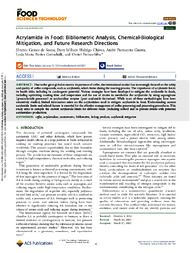Acrylamide in Food: Bibliometric analysis, chemical-biological mitigation, and future research directions.
Acrylamide in Food: Bibliometric analysis, chemical-biological mitigation, and future research directions.
Author(s): SOUZA, J. G. de; CHÁVEZ, D. W. H.; GUERRA, A. F.; GOTTSCHALK, L. M. F.; FREITAS-SILVA, O.
Summary: Due to the great global economic importance of coffee, the international market has increasingly focused on the safety and quality of coffee compounds, such as acrylamide, which forms during the roasting process. The importance of acrylamide lies in its health risks, including its carcinogenic potential. Various strategies have been developed to mitigate the acrylamide in foods, including optimizing roasting time and temperature and the use of strains to metabolize the acrylamide by using asparaginase (preacrylamide precursor) or acrylamidase enzyme (post acrylamide formation). While most of these methodologies have been extensively studied, limited information exists on the acrylamidase used to mitigate acrylamide in food. Understanding current acrylamide limits and related factors is essential for the effective management of coffee processing and processing procedures. This study aims to compile the current acrylamide limits for different foods (including coffee) and to present strains with potential acrylamidase production.
Publication year: 2025
Types of publication: Journal article
Unit: Embrapa Food Technology
Observation
Some of Embrapa's publications are published as ePub files. To read them, use or download one of the following free software options to your computer or mobile device. Android: Google Play Books; IOS: iBooks; Windows and Linux: Calibre.
Access other publications
Access the Agricultural Research Database (BDPA) to consult Embrapa's full library collection and records.
Visit Embrapa Bookstore to purchase books and other publications sold by Embrapa.

